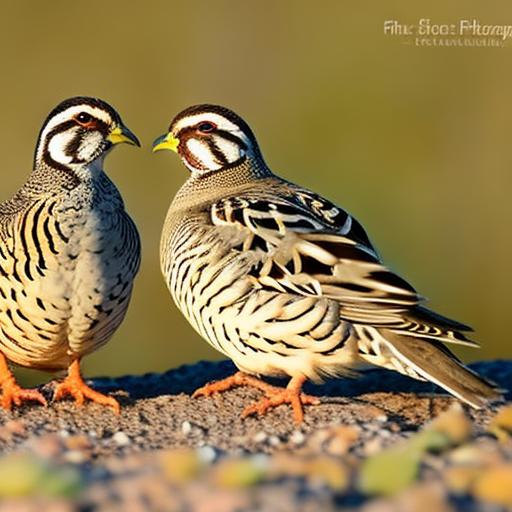Keeping male and female quails together can be a rewarding experience for poultry enthusiasts. Quails are social birds that thrive in the company of their own kind, and keeping a mixed-sex flock can provide a natural and dynamic environment for these birds to flourish. Whether you are interested in raising quails for their eggs, meat, or simply as pets, understanding the behavior and social dynamics of these birds is essential for successfully keeping male and female quails together. In this article, we will explore the intricacies of maintaining a mixed-sex quail flock, including potential challenges, breeding considerations, and tips for creating a suitable living environment for these birds.
Key Takeaways
- Keeping male and female quails together can be a rewarding experience for quail enthusiasts.
- Understanding quail behavior and social dynamics is crucial for successfully keeping male and female quails together.
- Potential challenges of keeping male and female quails together include aggression, overbreeding, and stress.
- Tips for successfully keeping male and female quails together include providing enough space, monitoring behavior, and separating aggressive birds.
- Breeding considerations for mixed-sex quail flocks include providing nesting boxes and monitoring egg production.
Understanding Quail Behavior and Social Dynamics
Quails are highly social birds that form strong bonds within their flocks. In the wild, they live in groups called coveys, which consist of both male and female birds. Within these coveys, quails establish a social hierarchy through various displays of dominance and submission. Understanding these social dynamics is crucial for keeping male and female quails together in a domestic setting. Male quails, known as cocks, can be territorial and may display aggressive behavior towards other males, especially during the breeding season. On the other hand, female quails, known as hens, may also exhibit territorial behavior when nesting or brooding. By observing and understanding these natural behaviors, poultry keepers can better manage their mixed-sex quail flocks and prevent potential conflicts.
Quails also communicate through various vocalizations and body language, which can provide valuable insights into their social interactions. For example, male quails may crow to assert their dominance or attract mates, while female quails may use different calls to communicate with their chicks or signal danger to the rest of the flock. By paying attention to these cues, poultry keepers can gain a deeper understanding of their quails’ social dynamics and intervene when necessary to maintain a harmonious flock.
Potential Challenges of Keeping Male and Female Quails Together
While keeping male and female quails together can be a rewarding experience, it also comes with its own set of challenges. One of the main challenges is managing aggression and territorial behavior, especially during the breeding season. Male quails may become more aggressive towards each other as they compete for the attention of female mates, leading to potential injuries or stress within the flock. Additionally, female quails may exhibit territorial behavior when nesting or brooding, which can also lead to conflicts within the flock. Another challenge is preventing overbreeding, as male quails may constantly pursue female mates, leading to excessive mating and potential stress for the hens.
Another potential challenge of keeping male and female quails together is the risk of inbreeding. Without proper management and monitoring, closely related birds may breed with each other, leading to genetic abnormalities and health issues in the offspring. Poultry keepers must be vigilant in monitoring the genetic diversity of their mixed-sex quail flocks to prevent inbreeding and maintain the overall health and vitality of their birds.
Tips for Successfully Keeping Male and Female Quails Together
Despite the potential challenges, there are several tips for successfully keeping male and female quails together in a domestic setting. Providing ample space and enrichment is essential for minimizing aggression and territorial behavior within the flock. By offering plenty of space to roam, dust bathe, and explore, quails can establish their own territories and reduce the likelihood of conflicts. Additionally, providing hiding spots such as shrubs or shelters can give quails a sense of security and privacy, especially during the breeding season.
Another tip is to maintain a balanced sex ratio within the flock. Having too many males compared to females can lead to increased aggression and competition for mates. Poultry keepers should aim for a ratio of one male to three or four females to ensure a harmonious social dynamic within the flock. Additionally, providing multiple feeding and watering stations can help reduce competition for resources and minimize potential conflicts.
Regular monitoring and observation of the flock’s behavior is crucial for identifying and addressing any potential issues early on. By paying attention to vocalizations, body language, and interactions within the flock, poultry keepers can intervene when necessary to prevent aggression or stress among their quails. Providing distractions such as hanging toys or treats can also help redirect aggressive behavior and provide mental stimulation for the birds.
Breeding Considerations for Mixed-Sex Quail Flocks
Breeding mixed-sex quail flocks requires careful planning and consideration to ensure the health and welfare of the birds. Poultry keepers should be prepared for the possibility of overbreeding and its potential impact on the hens’ well-being. Providing adequate nesting boxes and secluded areas for brooding can help minimize stress for the hens and provide a safe environment for raising chicks.
Another important consideration is managing the incubation and hatching process if breeding is desired. Poultry keepers can choose to let the hens incubate their eggs naturally or collect the eggs for artificial incubation. Both methods have their own advantages and challenges, so it’s important to weigh the options based on individual circumstances and resources.
Additionally, monitoring the genetic diversity of the flock is essential for preventing inbreeding and maintaining the overall health of the birds. Poultry keepers should keep detailed records of their quail’s lineage and consider introducing new bloodlines if necessary to diversify the gene pool.
Creating a Suitable Living Environment for Mixed-Sex Quail Flocks

Creating a suitable living environment for mixed-sex quail flocks is essential for their health and well-being. Providing a spacious outdoor area with access to natural vegetation, soil, and sunlight can offer enrichment opportunities for the birds and promote natural behaviors such as foraging and dust bathing. Additionally, offering a variety of perches, shelters, and hiding spots can give quails opportunities to establish territories and seek refuge when needed.
For indoor housing, providing adequate ventilation, lighting, and bedding materials is crucial for maintaining a clean and comfortable environment for the birds. Poultry keepers should also consider the layout of the housing to minimize aggression and competition among the birds. For example, dividing the space into separate areas with feeding and watering stations can help reduce conflicts over resources.
Maintaining good hygiene practices is essential for preventing disease outbreaks and promoting overall health within the flock. Regular cleaning of housing areas, nesting boxes, and feeding/watering stations can help minimize the risk of parasites and pathogens that can affect the birds’ well-being.
In conclusion, keeping male and female quails together can be a fulfilling experience for poultry enthusiasts who are willing to understand and manage the social dynamics of these birds. By providing a suitable living environment, monitoring behavior, and implementing thoughtful breeding considerations, poultry keepers can successfully maintain a harmonious mixed-sex quail flock while enjoying the benefits of their companionship, eggs, or meat production.
If you’re considering keeping male and female quails together, it’s important to provide them with a suitable living environment. A well-designed coop, such as the Snaplock Chicken Coop from Poultry Wizard, can offer the space and security needed for quails to thrive. Additionally, ensuring the coop is equipped with a reliable heater, like the one featured in Poultry Wizard’s article on heaters for chicken coops, can help maintain optimal conditions for your quails. For those looking to integrate their quail coop into a garden setting, Poultry Wizard’s guide on garden chicken coops offers valuable insights on creating a harmonious and functional space for both your quails and plants. Check out the article here to learn more about creating an ideal environment for your male and female quails.
FAQs
Can you keep male and female quails together?
Yes, you can keep male and female quails together in the same enclosure.
Do male and female quails get along?
In general, male and female quails get along well and can coexist peacefully in the same space.
Will male and female quails breed if kept together?
Yes, if male and female quails are kept together, they are likely to breed and produce offspring.
Are there any special considerations for keeping male and female quails together?
It’s important to provide enough space and hiding spots for the female quail to escape from the male if she needs a break from mating. Additionally, monitoring the breeding behavior and ensuring the female is not being overly harassed by the male is important.
What should I do if I want to prevent breeding between male and female quails?
If you want to prevent breeding between male and female quails, you can separate them into different enclosures or remove the eggs laid by the female to prevent hatching.
Meet Walter, the feathered-friend fanatic of Florida! Nestled in the sunshine state, Walter struts through life with his feathered companions, clucking his way to happiness. With a coop that’s fancier than a five-star hotel, he’s the Don Juan of the chicken world. When he’s not teaching his hens to do the cha-cha, you’ll find him in a heated debate with his prized rooster, Sir Clucks-a-Lot. Walter’s poultry passion is no yolk; he’s the sunny-side-up guy you never knew you needed in your flock of friends!







